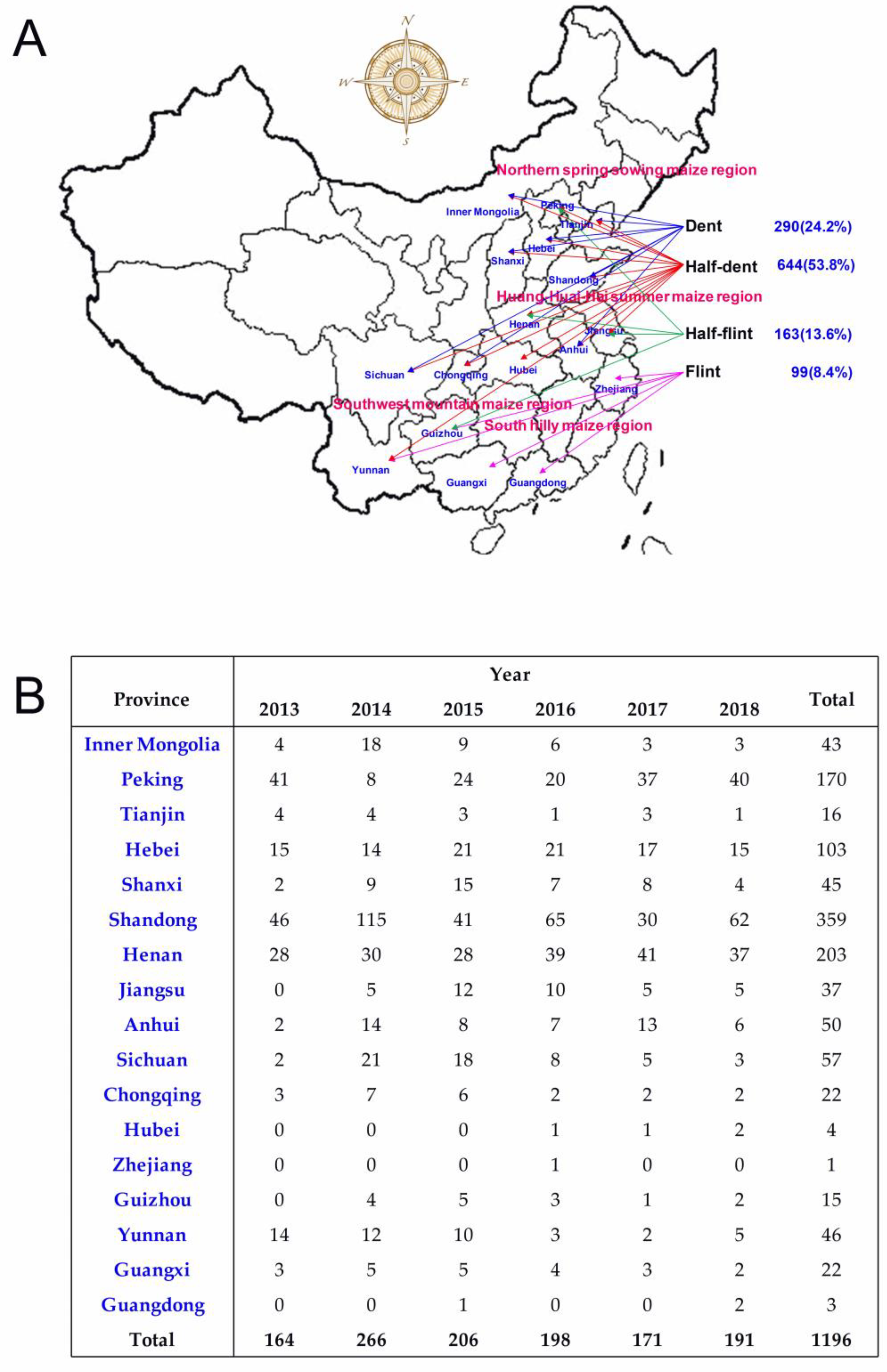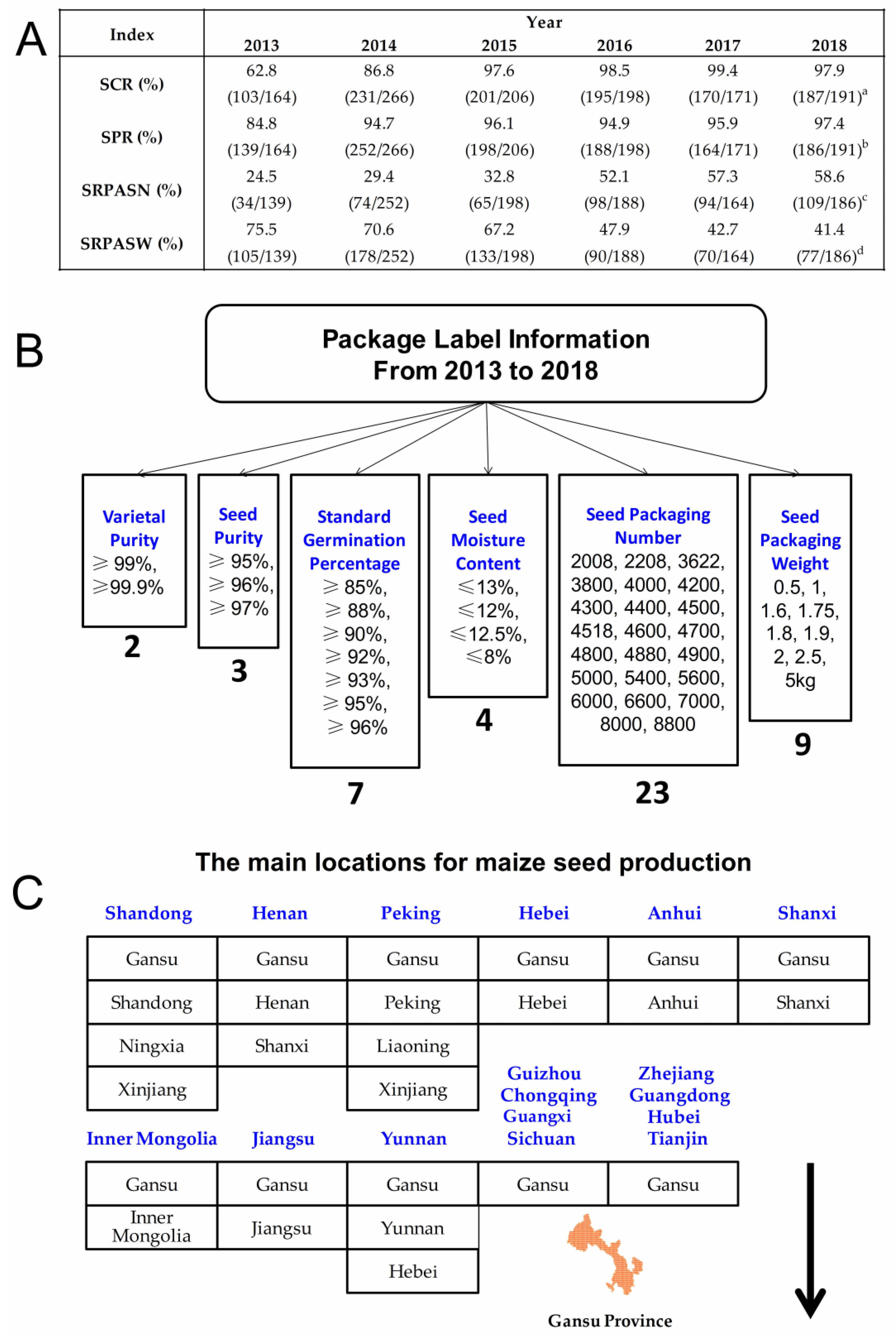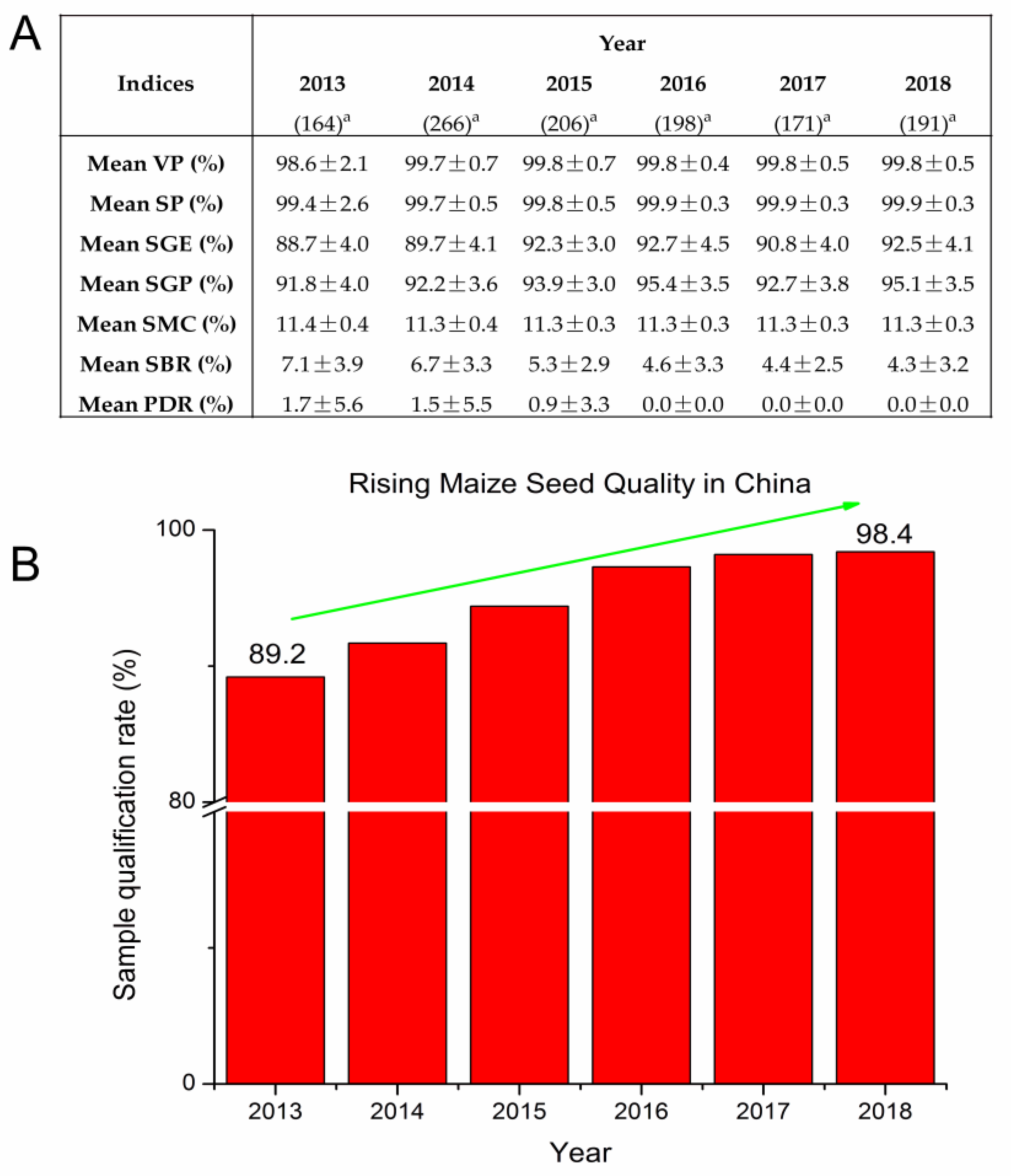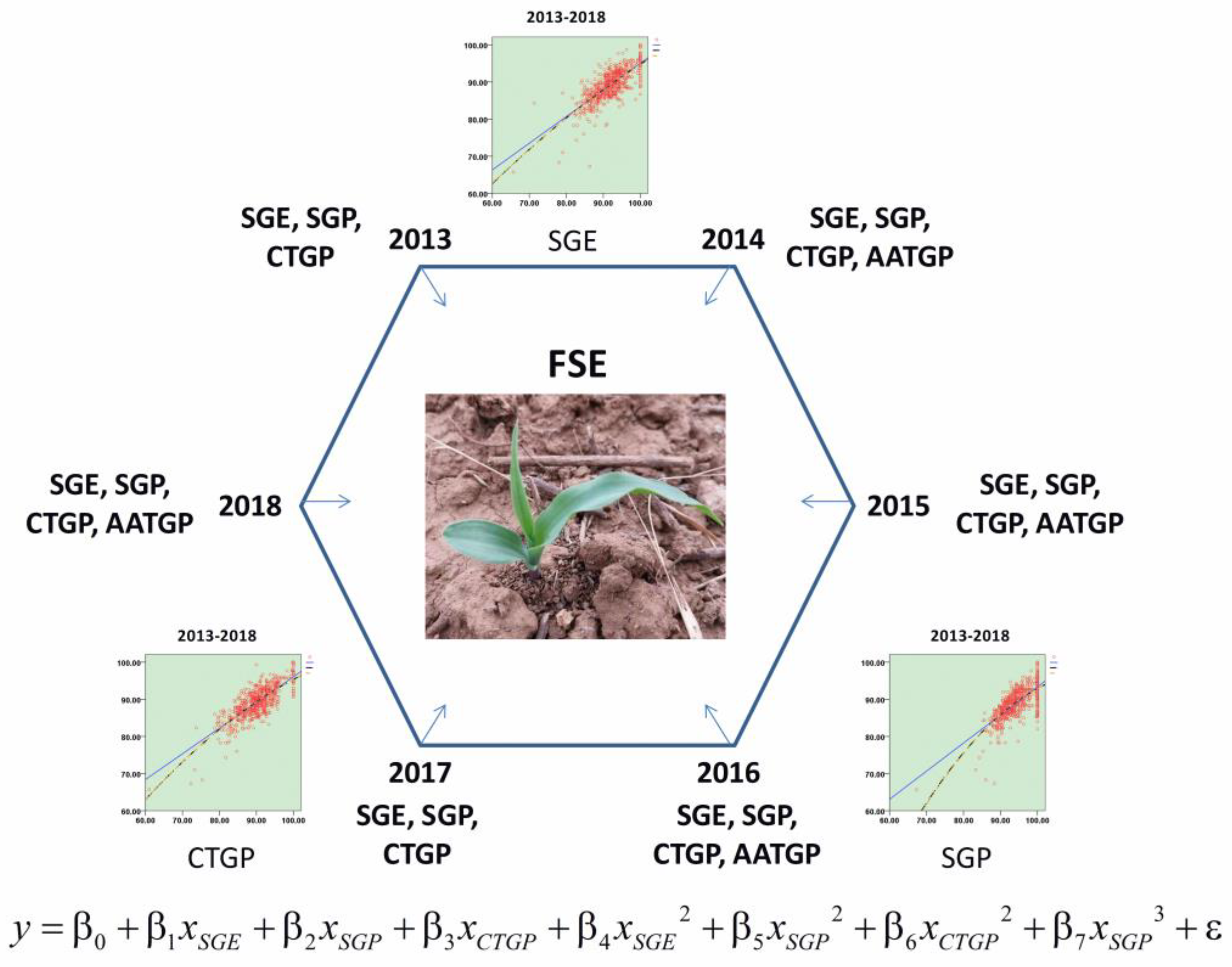A Comparative Analysis of the Hybrid Maize (Zea mays L.) Seed Quality in China from 2013 to 2018
Abstract
:1. Introduction
2. Materials and Methods
2.1. Region
2.2. Plant Materials
2.3. Measurements
2.3.1. Sample Information
2.3.2. Seed Purity and Varietal Purity Test
2.3.3. Sample Seed Type Classification
2.3.4. Thousand-Seed Weight, Seed Moisture Content, Seed Bulk Density, and Seed Hardness Test
2.3.5. Total Starch Content, Crude Protein Content, and Crude Fat Content Test
2.3.6. Germination Test
2.3.7. Samples Met the Prescribed Quality Standards Test
2.3.8. Pest Damage Rate Test
2.3.9. Seed Breakage Rate Test
2.3.10. Cold Test and Accelerated Aging Test
2.3.11. Field Seedling Emergence Test
2.4. Statistical Analysis
3. Results
3.1. Overview of Sample Collection
3.2. Comparative Analysis of Mean Values of Seed Quality Indices and Sample Qualification Rate (Namely the Percentage of Samples Which Met the Prescribed Quality Standards) from 2013 to 2018
3.3. Descriptive Statistics Analysis of Seed Quality Indices from 2013 to 2018
3.4. Principal Component Analysis of Seed Quality Indices from 2013 to 2018
3.5. Cluster Analysis of Maize Seed Quality Indices from 2013 to 2018
3.6. Correlation Analysis of Maize Seed Quality Indices
3.7. Variance Analysis of Maize Seed Quality Indices from 2013 to 2018
3.8. Regression Analysis for Data of Maize Seed Quality Indices from 2013 to 2018
4. Discussion
5. Conclusions
Supplementary Materials
Author Contributions
Funding
Acknowledgments
Conflicts of Interest
Abbreviations
| AATGP | accelerated aging test germination percentage |
| CCYS | column compression yield stress |
| CFC | crude fat content |
| CPC | crude protein content |
| CTGP | cold test germination percentage |
| FCYS | flat compression yield stress |
| FSE | mean field seedling emergence |
| PDR | pest damage rate |
| SBD | seed bulk density |
| SBR | seed breakage rate |
| SCR | sample coating rate, namely the percentage of samples with coated seed |
| SCYS | side compression yield stress |
| SGE | standard germination energy |
| SGP | standard germination percentage |
| SMC | seed moisture content |
| SP | seed purity |
| SPR | sample packaging rate |
| SRPASN | sample rate of packaging according to seed number |
| SRPASW | sample rate of packaging according to seed weight |
| TSC | total starch content |
| TSW | thousand-seed weight |
| VP | varietal purity |
References
- Chen, Y.L.; Xiao, C.X.; Wu, D.L.; Xia, T.T.; Chen, Q.W.; Chen, F.J.; Yuan, L.X.; Mi, G.H. Effects of nitrogen application rate on grain yield and grain nitrogen concentration in two maize hybrids with contrasting nitrogen remobilization efficiency. Eur. J. Agron. 2015, 62, 79–89. [Google Scholar] [CrossRef]
- Li, A.L.; Ma, Y.G.; Yang, M.K.; Zhang, Y.; Ma, X.L. Effects of different harvest time on seed vigor of maize hybrid Qidan 1. Shandong Agric. Sci. 2014, 46, 34–37. [Google Scholar]
- Rajjou, L.; Debeaujon, I. Seed longevity: Survival and maintenance of high germination ability of dry seeds. C. R. Biol. 2008, 331, 796–805. [Google Scholar] [CrossRef] [PubMed]
- Rajjou, L.; Duval, M.; Gallardo, K.; Catusse, J.; Bally, J.; Job, C.; Job, D. Seed germination and vigor. Annu. Rev. Plant Biol. 2012, 63, 507–533. [Google Scholar] [CrossRef] [PubMed]
- Marcos-Filho, J. Seed vigor testing: An overview of the past, present and future perspective. Sci. Agric. 2015, 72, 363–374. [Google Scholar] [CrossRef]
- Gu, R.L.; Li, L.; Liang, X.L.; Wang, Y.B.; Fan, T.L.; Wang, Y.; Wang, J.H. The ideal harvest time for seeds of hybrid maize (Zea mays L.) XY335 and ZD958 produced in multiple environments. Sci. Rep. 2017, 7, 17537. [Google Scholar] [CrossRef] [PubMed]
- Wang, M.M.; Qu, H.B.; Zhang, H.D.; Liu, S.; Li, Y.; Zhang, C.Q. Hormone and RNA-seq analyses reveal the mechanisms underlying differences in seed vigour at different maize ear positions. Plant Mol. Biol. 2019, 99, 461–476. [Google Scholar] [CrossRef]
- Han, Z.P.; Ku, L.X.; Zhang, Z.Z.; Zhang, J.; Guo, S.L.; Liu, H.Y.; Zhao, R.F.; Ren, Z.Z.; Zhang, L.K.; Su, H.H.; et al. QTLs for seed vigor-related traits identified in maize seeds germinated under artificial aging conditions. PLoS ONE 2014, 9, e92535. [Google Scholar] [CrossRef]
- Revilla, P.; Butron, A.; Rodriguez, V.M.; Malvar, R.A.; Ordas, A. Identification of genes related to germination in aged maize seed by screening natural variability. J. Exp. Bot. 2009, 60, 4151–4157. [Google Scholar] [CrossRef]
- Li, T.; Zhang, Y.M.; Wang, D.; Liu, Y.; Dirk, L.M.A.; Goodman, J.; Downie, A.B.; Wang, J.M.; Wang, G.Y.; Zhao, T.Y. Regulation of seed vigor by manipulation of raffinose family oligosaccharides (RFOs) in maize and Arabidopsis. Mol. Plant 2017, 10, 1540. [Google Scholar] [CrossRef]
- Jiang, X.W.; Tian, B.H.; Zhang, W.M.; Wang, G.Y.; Wang, J.H. QTL mapping of coleorhiza length in maize (Zea mays L.) under two germination environmental conditions. Plant Breed. 2011, 130, 625–632. [Google Scholar] [CrossRef]
- Li, X.H.; Wang, G.H.; Fu, J.J.; Li, L.; Jia, G.Y.; Ren, L.S.; Lubberstedt, T.; Wang, G.Y.; Wang, J.H.; Gu, R.L. QTL mapping in three connected populations reveals a set of consensus genomic regions for low temperature germination ability in Zea mays L. Front. Plant Sci. 2018, 9, 1–11. [Google Scholar] [CrossRef] [PubMed]
- Zhang, W.J.; Li, H.Q.; Jiang, X.W. The investigation and analysis of the results of farmers to realize the seed quality of maize in Shandong province. J. Anhui. Agric. Sci. 2014, 42, 8795–8796. [Google Scholar]
- Wang, X.K.; Li, H.Q.; Jiang, X.W.; Wang, J.H. Analysis and proposals for commercial hybrid maize seed quality in shandong province. Shandong Agric. Sci. 2015, 47, 33–35. [Google Scholar] [CrossRef]
- Chinese Academy of Agricultural Sciences. Territorial Crop Conformation; China Agricultural Press: Beijing, China, 1984. [Google Scholar]
- ISTA. International Rules for Seed Testing; International Seed Testing Association: Bassersdorf, Switzerland, 2019. [Google Scholar]
- Standardization Administration. Rules for Agricultural Seed Testing; Standards Press of China: Beijing, China, 1995. [Google Scholar]
- Ma, Q.; Wang, Y.; Guo, H.; Zhu, D.H.; Liu, Z.; Zhang, X.D.; Li, S.M. High-throughput maize grain type identification system based on sparse representation algorithm. Trans. Chin. Soc. Agric. Eng. 2017, S1, 219–224. [Google Scholar] [CrossRef]
- Liu, H.B.; Zhang, W.M.; Gao, C.H.; Yao, D.N.; Zhang, C.Q.; Hu, J. Effect of different grading of grain on maize seed vigor and plant growth. Seed 2013, 32, 26–32. [Google Scholar] [CrossRef]
- ISTA. Handbook on Moisture Determination; International Seed Testing Association: Bassersdorf, Switzerland, 2007. [Google Scholar]
- Zeng, F.K.; Zhao, X.; Zhou, T.H.; Liu, G. Dual-wavelength colorimetric method for measuring amylose and amylopectin contents of potato starch. Mod. Food Sci. Technol. 2012, 28, 119–122. [Google Scholar] [CrossRef]
- Kjeldahl, J. A new method for the determination of nitrogen in organic matter. Z. Anal. Chem. 1883, 22, 366. [Google Scholar] [CrossRef]
- Yang, X.S.; Wang, L.L.; Zhou, X.R.; Shuang, S.M.; Zhu, Z.H.; Li, N.; Li, Y.; Liu, F.; Liu, S.C.; Lu, P.; et al. Determination of protein, fat, starch, and amino acids in foxtail millet [Setaria italica (L.) Beauv.] by fourier transform near-infrared reflectance spectroscopy. Food Sci. Biotechnol. 2013, 22, 1495–1500. [Google Scholar] [CrossRef]
- Yin, Y.P.; Dong, X.H. The Experimental Technology of Seed Science; China Agriculture Press: Beijing, China, 2015. [Google Scholar]
- Jiang, X.W.; Li, H.Q.; Wei, Y.J.; Song, X.Y.; Wang, J.H. Seed biomechanical monitoring: A new method to test maize (Zea mays) seed vigour. Seed Sci. Technol. 2016, 44, 382–392. [Google Scholar] [CrossRef]
- The National People’s Congress. The Seed Law of The People’s Republic of China; China Legal Publishing House: Beijing, China, 2016. [Google Scholar]
- Standardization Administration. GB/T4404.1-2008, Seed of Food Crops—Part 1: Cereals; Standards Press of China: Beijing, China, 2008. [Google Scholar]
- ISTA. Handbook of Seed Vigour Test Methods; International Seed Testing Association: Bassersdorf, Switzerland, 1995. [Google Scholar]
- Zhao, G.W.; Zhong, T.L.; Ying, Y.Q. The Modern Seed and Seedling Lab Manual; China Agriculture Press: Beijing, China, 2015. [Google Scholar]
- Wang, J.H. Seed Quality Testing and Evaluation Manual of Corn (Zea mays); China Agricultural University Press: Beijing, China, 2016. [Google Scholar]
- Matthews, S.; Wagner, M.H.; El-Khadem, R.; Casarini, E.; Khajeh-Hosseini, M.; Nasehzadeh, M. Rate of physiological germination compared with the cold test and accelerated ageing as a repeatable vigour test for maize. Seed Sci. Technol. 2010, 38, 379–389. [Google Scholar] [CrossRef]
- SAS Institute. SAS Procedures Guide; Version 6; SAS/STAT Institute, Inc.: Cary, NC, USA, 1999. [Google Scholar]
- Zhang, W.M.; Jiang, X.W.; Wang, Y.; Liu, X.Y.; Duan, X.Y.; Han, W.T.; Wang, J.H. Investigation report on seed production in Jiuquan region of Gansu province. China Seed Ind. 2011, 6, 32–34. [Google Scholar] [CrossRef]
- Zhang, X.W.; Wang, S.E.; Shao, X.Y.; Guo, S.Q.; Li, H.Q.; Wang, J.H.; Song, X.Y.; Jiang, X.W. Maize seed quality of main producing region in China. J. Maize Sci. 2017, 25, 42–50. [Google Scholar] [CrossRef]
- Zhao, L.; Han, Z.; Yang, J.; Qi, H. Single seed precise sowing of maize using computer simulation. PLoS ONE 2018, 13, e0193750. [Google Scholar] [CrossRef] [PubMed]
- Scott, J.M. Seed coatings and treatments and their effects on plant establishment. Adv. Agron. 1989, 42, 43–83. [Google Scholar] [CrossRef]
- Copeland, L.O.; McDonald, M.B. Principles of Seed Science and Technology, 3rd ed.; Chapman and Hall: New York, NY, USA, 1995. [Google Scholar]
- Hara, Y. Comparison of the effects of seed coating with tungsten and molybdenum compounds on seedling establishment rates of rice, wheat, barley, and soybean under flooded conditions. Plant Prod. Sci. 2017, 20, 406–411. [Google Scholar] [CrossRef] [Green Version]
- Pedrini, S.; Merritt, D.J.; Stevens, J.; Dixon, K. Seed coating: Science or marketing spin? Trends Plant Sci. 2017, 22, 106–116. [Google Scholar] [CrossRef]
- Zhang, L.; Dong, S.T.; Liu, C.H.; Wang, K.J.; Zhang, J.W.; Liu, P. Correlation analysis on maize test weight, yield and quality. Sci. Agric. Sin. 2007, 40, 405–411. [Google Scholar]
- Gasparis, S.; Orczyk, W.; Zalewski, W.; Nadolska-Orczyk, A. The RNA-mediated silencing of one of the Pin genes in allohexaploid wheat simultaneously decreases the expression of the other, and increases grain hardness. J. Exp. Bot. 2011, 62, 4025–4036. [Google Scholar] [CrossRef] [Green Version]
- Arena, S.; D’Ambrosio, C.; Vitale, M.; Mazzeo, F.; Mamone, G.; Stasio, L.D.; Maccaferri, M.; Curci, P.L.; Sonnante, G.; Zambrano, N.; et al. Differential representation of albumins and globulins during grain development in durum wheat and its possible functional consequences. J. Proteomics 2017, 162, 86–98. [Google Scholar] [CrossRef]
- Li, G.R.; Gao, D.; La, S.X.; Wang, H.J.; Li, J.B.; He, W.L.; Yang, E.N.; Yang, Z.J. Characterization of wheat-Secale africanum chromosome 5Ra derivatives carrying Secale specific genes for grain hardness. Planta 2016, 243, 1203–1212. [Google Scholar] [CrossRef] [PubMed]
- Styer, R.C.; Cantliffe, D.J. Dependence of seed vigor during germination on carbohydrate source in endosperm mutants of maize. Plant Physiol. 1984, 76, 196–200. [Google Scholar] [CrossRef] [PubMed]




| Indices | Initial | Extraction | |||||
|---|---|---|---|---|---|---|---|
| 2013 | 2014 | 2015 | 2016 | 2017 | 2018 | ||
| TSW | 1.000 | 0.686 | 0.786 | 0.775 | 0.540 | 0.569 | 0.638 |
| SBD | 1.000 | 0.379 | 0.736 | 0.612 | 0.639 | 0.743 | 0.659 |
| FCYS | 1.000 | 0.723 | 0.706 | 0.630 | 0.565 | 0.639 | 0.676 |
| SCYS | 1.000 | 0.624 | 0.582 | 0.640 | 0.525 | 0.653 | 0.663 |
| CCYS | 1.000 | 0.638 | 0.588 | 0.434 | 0.527 | 0.686 | 0.416 |
| SMC | 1.000 | 0.851 | 0.563 | 0.798 | 0.507 | 0.747 | 0.743 |
| TSC | 1.000 | 0.553 | 0.575 | 0.632 | 0.627 | 0.467 | 0.584 |
| CPC | 1.000 | 0.614 | 0.628 | 0.711 | 0.583 | 0.720 | 0.662 |
| CFC | 1.000 | 0.697 | 0.732 | 0.578 | 0.846 | 0.738 | 0.602 |
| SGE | 1.000 | 0.760 | 0.861 | 0.784 | 0.809 | 0.790 | 0.841 |
| SGP | 1.000 | 0.776 | 0.844 | 0.750 | 0.831 | 0.780 | 0.840 |
| CTGP | 1.000 | 0.569 | 0.811 | 0.744 | 0.748 | 0.844 | 0.872 |
| AATGP | 1.000 | 0.635 | 0.594 | 0.426 | 0.413 | 0.524 | 0.614 |
| FSE | 1.000 | 0.660 | 0.838 | 0.728 | 0.780 | 0.809 | 0.866 |
| Component | Initial Eigenvalues | Initial Eigenvalues | ||||
|---|---|---|---|---|---|---|
| Total | % of Variance | Cumulative % | Total | % of Variance | Cumulative % | |
| 2013 | 2014 | |||||
| 1 | 3.499 | 24.991 | 24.991 | 4.387 | 31.335 | 31.335 |
| 2 | 1.786 | 12.760 | 37.751 | 1.898 | 13.558 | 44.894 |
| 3 | 1.454 | 10.389 | 48.14 | 1.341 | 9.576 | 54.469 |
| 4 | 1.317 | 9.405 | 57.545 | 1.125 | 8.033 | 62.503 |
| 5 | 1.108 | 7.912 | 65.457 | 1.093 | 7.810 | 70.313 |
| 2015 | 2016 | |||||
| 1 | 3.804 | 27.171 | 27.171 | 3.433 | 24.520 | 24.520 |
| 2 | 1.946 | 13.898 | 41.069 | 1.824 | 13.029 | 37.549 |
| 3 | 1.408 | 10.059 | 51.127 | 1.498 | 10.697 | 48.246 |
| 4 | 1.067 | 7.619 | 58.746 | 1.121 | 8.009 | 56.255 |
| 5 | 1.018 | 7.270 | 66.016 | 1.064 | 7.601 | 63.856 |
| 2017 | 2018 | |||||
| 1 | 4.030 | 28.787 | 28.787 | 4.339 | 30.992 | 30.992 |
| 2 | 1.972 | 14.088 | 42.875 | 1.791 | 12.793 | 43.786 |
| 3 | 1.496 | 10.687 | 53.562 | 1.324 | 9.454 | 53.24 |
| 4 | 1.117 | 7.978 | 61.541 | 1.152 | 8.226 | 61.467 |
| 5 | 1.095 | 7.820 | 69.361 | 1.069 | 7.637 | 69.103 |
| Year | Group | Indices | |||||
|---|---|---|---|---|---|---|---|
| 2013 | 1 | SGE | SGP | FSE | CTGP | AATGP | TSC |
| 2 | SBD | ||||||
| 3 | TSW | ||||||
| 4 | SMC | ||||||
| 5 | FCYS | SCYS | |||||
| 6 | CCYS | CFC | |||||
| 7 | CPC | ||||||
| 2014 | 1 | SGE | SGP | FSE | CTGP | AATGP | TSC |
| 2 | SBD | FCYS | |||||
| 3 | CFC | ||||||
| 4 | SCYS | CCYS | |||||
| 5 | SMC | ||||||
| 6 | TSW | ||||||
| 7 | CPC | ||||||
| 2015 | 1 | SGE | SGP | CTGP | FSE | AATGP | TSC |
| 2 | FCYS | SCYS | SBD | ||||
| 3 | TSW | ||||||
| 4 | CCYS | CFC | |||||
| 5 | CPC | ||||||
| 6 | SMC | ||||||
| 2016 | 1 | SGE | SGP | CTGP | FSE | AATGP | TSC |
| 2 | SBD | FCYS | SCYS | ||||
| 3 | TSW | ||||||
| 4 | SMC | ||||||
| 5 | CCYS | CFC | |||||
| 6 | CPC | ||||||
| 2017 | 1 | CTGP | FSE | SGE | SGP | TSC | AATGP |
| 2 | SBD | FCYS | SCYS | TSW | |||
| 3 | CCYS | CFC | CPC | ||||
| 4 | SMC | ||||||
| 2018 | 1 | SGP | FSE | CTGP | SGE | AATGP | |
| 2 | FCYS | SCYS | CCYS | TSC | |||
| 3 | CPC | ||||||
| 4 | TSW | CFC | |||||
| 5 | SMC | SBD | |||||
| Year | TSW | SBD | FCYS | SCYS | CCYS | SMC | TSC | CPC | CFC | SGE | SGP | CTGP | AATGP |
|---|---|---|---|---|---|---|---|---|---|---|---|---|---|
| 2013 | 0.182 | 0.187 | 0.046 | −0.041 | −0.124 | −0.054 | 0.382 ** | −0.013 | 0.013 | 0.650 ** | 0.551 ** | 0.578 ** | 0.383 ** |
| 2014 | 0.055 | 0.352 ** | 0.170 | −0.006 | −0.063 | −0.035 | 0.354 ** | 0.15 | 0.242 * | 0.795 ** | 0.803 ** | 0.798 ** | 0.585 ** |
| 2015 | 0.023 | 0.280 ** | 0.132 | 0.159 | −0.109 | −0.051 | 0.228 * | 0.054 | 0.066 | 0.674 ** | 0.621 ** | 0.697 ** | 0.421 ** |
| 2016 | 0.107 | 0.249 * | 0.163 | 0.179 | 0.010 | 0.010 | 0.189 | −0.038 | 0.215 * | 0.556 ** | 0.592 ** | 0.695 ** | 0.430 ** |
| 2017 | 0.103 | 0.224 * | 0.313 ** | 0.023 | 0.008 | −0.022 | 0.487 ** | −0.016 | −0.077 | 0.730 ** | 0.677 ** | 0.833 ** | 0.428 ** |
| 2018 | 0.112 | 0.236 * | 0.226 * | 0.239 | 0.072 | −0.003 | 0.130 | 0.083 | 0.000 | 0.382 ** | 0.819 ** | 0.838 ** | 0.639 ** |
| 30 varieties | 0.151 | 0.471 ** | 0.472 * | 0.277 | 0.151 | −0.211 | 0.267 | −0.162 | −0.193 | 0.789 ** | 0.633 ** | 0.778 ** | 0.725 ** |
| Indices | 2013 | 2014 | 2015 | 2016 | 2017 | 2018 |
|---|---|---|---|---|---|---|
| Mean TSW (g) | 334.8 abAB | 334.0 abAB | 337.9 aAB | 327.6 bB | 334.9 abAB | 339.6 aA |
| Mean SBD (g/L) | 736.8 bB | 739.8 abAB | 744.9 aA | 739.6 abAB | 738.5 bAB | 742.0 abAB |
| Mean FCYS (KN) | 2.6 cB | 2.8 aAB | 2.6 bcB | 2.7 abAB | 2.7 abAB | 2.8 aA |
| Mean SCYS (KN) | 1.6 bA | 1.6 abA | 1.6 bA | 1.7 aA | 1.6 abA | 1.7 abA |
| Mean CCYS (KN) | 0.8 bB | 0.8 abAB | 0.9 aAB | 0.9 aAB | 0.9 aA | 0.9 abAB |
| Mean SMC (%) | 11.3 (3) aA | 11.2 (8) abAB | 11.2 (5) bB | 11.2 (6) bAB | 11.2 (6) bAB | 11.2 (5) bB |
| Mean TSC (%) | 72.5 aA | 72.7 aA | 72.5 abA | 71.8 bA | 72.1 abA | 72.4 abA |
| Mean CPC (%) | 9.9 aAB | 9.7 bB | 9.8 abAB | 9.8 abAB | 10.0 aA | 9.9 abAB |
| Mean CFC (%) | 4.2 aA | 4.2 aA | 4.2 aA | 4.2 aA | 4.2 aA | 4.2 aA |
| Mean SGE (%) | 88.8 dE | 90.4 cD | 92.6 bBC | 94.3 aA | 91.1 cCD | 93.5 abAB |
| Mean SGP (%) | 92.4 dB | 93.4 cB | 95.2 bA | 96.4 aA | 93.1 cdB | 96.0 abA |
| Mean CTGP (%) | 85.8 dC | 88.6 cB | 89.8 bB | 91.7 aA | 91.7 aA | 92.2 aA |
| Mean AATGP (%) | 79.6 cB | 83.0 bA | 83.9 abA | 84.7 abA | 82.6 bAB | 85.5 aA |
| Mean FSE (%) | 85.7 dD | 89.3 bcBC | 89.6 bcBC | 90.4 abAB | 88.7 cC | 91.2 aA |
© 2019 by the authors. Licensee MDPI, Basel, Switzerland. This article is an open access article distributed under the terms and conditions of the Creative Commons Attribution (CC BY) license (http://creativecommons.org/licenses/by/4.0/).
Share and Cite
Li, H.; Yue, H.; Li, L.; Su, C.; Zhang, X.; Liu, J.; Yu, Z.; Zhao, G.; Song, X.; Wang, J.; et al. A Comparative Analysis of the Hybrid Maize (Zea mays L.) Seed Quality in China from 2013 to 2018. Agronomy 2019, 9, 625. https://doi.org/10.3390/agronomy9100625
Li H, Yue H, Li L, Su C, Zhang X, Liu J, Yu Z, Zhao G, Song X, Wang J, et al. A Comparative Analysis of the Hybrid Maize (Zea mays L.) Seed Quality in China from 2013 to 2018. Agronomy. 2019; 9(10):625. https://doi.org/10.3390/agronomy9100625
Chicago/Turabian StyleLi, Heqin, Haiwang Yue, Li Li, Chengfu Su, Xiaowen Zhang, Jing Liu, Zhiyang Yu, Guangwu Zhao, Xiyun Song, Jianhua Wang, and et al. 2019. "A Comparative Analysis of the Hybrid Maize (Zea mays L.) Seed Quality in China from 2013 to 2018" Agronomy 9, no. 10: 625. https://doi.org/10.3390/agronomy9100625
APA StyleLi, H., Yue, H., Li, L., Su, C., Zhang, X., Liu, J., Yu, Z., Zhao, G., Song, X., Wang, J., & Jiang, X. (2019). A Comparative Analysis of the Hybrid Maize (Zea mays L.) Seed Quality in China from 2013 to 2018. Agronomy, 9(10), 625. https://doi.org/10.3390/agronomy9100625






